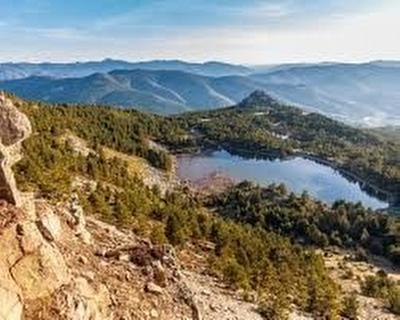Discovering Spain’s Sierra de la Demanda: the land that social media forgot

© An abandoned railway station speaks to the depopulation of this region of España vacía. Photograph:
While other parts of Spain struggle with the pressures of over-tourism, these wild, expansive and almost tourist-free mountains are a lungful of fresh air
As with paint colours or lipstick shades, naming a mountain range requires serious consideration. It should suggest character, create intrigue, and kindle desire. Who doesn’t want to explore the Crazy Mountains of Montana, or make a fiery pact with California’s Diablo Range? While studying a map of Spain, my interest was piqued by a patch of grey and green emptiness bearing the enticing words: Sierra de la Demanda.
I’ve travelled all over Spain for work and play in the last two decades, but somehow these “demanding” mountains had eluded me. Located in the remote northern interior, halfway between Madrid and Santander, their isolation (and a dearth of English-language Google results) only added to the mystique. The Sierra de la Demanda covers a vast area across Spain’s least populated regions of Burgos, Soria and La Rioja. An investigation of more detailed maps revealed an almost roadless expanse of limestone peaks, valleys, ravines, rivers, gorges and glacial lakes, with the highest peak, San Lorenzo, towering at 2,271 metres (7,451ft). The calling was real.
The views are stupendous in every direction – fold upon fold of untouched mountain wilderness and nothing human-made in sight
The town of Ezcaray, on the north side, is the closest thing to a tourist hub – a scenic former textile centre on the River Oja that operates as a base for the small ski resort of Valdezcaray, built in the 1970s (the Palacio Azcárate has doubles from €90, B&B). The sealed road ends abruptly after the ski centre, becoming a rocky trail that makes for a nail-biting drive (especially in a hire car) along a ridge that’s at more than 1,800 metres (6,000ft), before looping back to Ezcaray in a dizzying descent of hairpin bends. The views are stupendous in every direction – fold upon fold of untouched mountain wilderness and, apart from the occasional hiking trail signpost, nothing human-made in sight.
On their south side, heading downhill from the lagunas, the Demanda feel different. The climate turns drier and warmer, and Spain becomes familiar again, with its oak forests, medieval ermitas (chapels) and sleepy villages where old men wave from their chairs outside the taverna. Although there are plenty of well-marked hiking and mountain bike trails here, this is still “España vacía” – empty Spain – and human activity remains a rare sight outside the towns. This phenomenon of the interior’s depopulation is much discussed by Spanish politicians and citizens, and the low density is tangible here – traffic is light and most of the activity is among the animal kingdom. Deer leap through the trees, boar amble across the road, and as the forests give way to open rocky landscapes, griffon vultures perch in their hundreds along the high cliffs before swooping and circling in the late afternoon thermals.
The village of Quintanar de la Sierra, in the southern foothills, makes a good base to explore the Demanda, and the Hostal Domingo offers affordable rooms (doubles from €55, room-only). Like all the villages in the area, life moves slowly and peacefully. Locals get around on horses and in beat-up 4x4s, the shops shut all afternoon, nobody speaks English, and everyone, young and old, socialises in the town plaza where a café con leche will set you back €1.50. Like the ski centre, the hotels and bars are a non-ironic throwback to the 1970s, their only concession to the 21st century being charmingly rudimentary websites and an email address. This is the land that social media forgot, and is better off for it. Although it may appear on the surface that there’s not much in the way of tourist attractions, as you delve deeper into its hidden corners, an intriguing and eclectic landscape of history and culture reveals itself.
Just over the hill is one of cinema’s most well-known locations, where The Good, The Bad & The Ugly was filmed in 1966
Dinosaurs roamed this part of Spain, and hundreds of their footprints are visible near the town of Salas de los Infantes, which also boasts a dinosaur museum. Moving on a few miles, and a few million years, is the eerie Necrópolis de Cuyacabras, dating from the ninth to 11th centuries, where dozens of adult- and child-size tombs are carved from a slab of rock in the depth of a pine forest. Meandering through the villages, Roman bridges, abandoned monasteries and ruins of all eras – from medieval to mid-century – appear at every turn. For lovers of industrial archaeology (AKA clambering around abandoned buildings), an enticing disused railway runs through Salas, its crumbling stations and rusty tracks half hidden beneath tangles of vegetation.
Three miles over the hill from Silos, you’ll find yourself at an altogether different but equally revered site – Sad Hill cemetery, one of cinema’s most well-known locations, where the closing scene of The Good, The Bad & The Ugly was filmed in 1966. Twenty miles west, venturing deeper into fantasy land, is the Territorio Artlanza, which claims to be the largest sculpture in the world. A magical, full-scale reproduction of a medieval Castilian village, created by Félix Yáñez, a local artist, from materials salvaged from rubbish dumps, it includes porticoed squares, a perfectly equipped school, a carpentry shop, bakery, forge, canteen, wine cellars, an alchemist’s pharmacy and even a small chapel.
Empty patches on maps that elicit few Google search results are rare in these hyperconnected, overshared times. There is a timelessness to the Sierra de la Demanda that feels like innocence, and while other parts of Spain struggle with the pressures of over-tourism, these mountains are a lungful of fresh air. The charms of the Demanda are simple and unshowy, and ironically, make few demands on the visitor – except to breathe deeply and tread lightly.

© The eerie Necrópolis de Cuyacabras, where dozens of adult- and child-sized tombs are carved from a s

© The Territorio Artlanza is a full-scale reproduction of a medieval Castilian village, created by local artist Félix Yáñez. Photograph: Wirestock/Alamy
« Viaje al Jurásico ibérico: din ... n 'España' Este fin de semana se celebra ... inosaurios »








